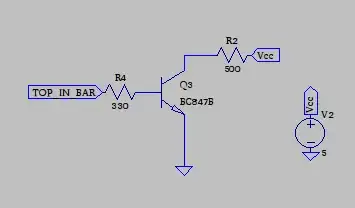It sounds like you are talking about a source that is generating a 5 volt square wave and you are expecting, due to a potential divider effect, the see 2.5 volt peak, yes?
Yes, you are correct.
Take a 1N4148 diode for example: -

When your signal generator is putting out a 5 volt peak, the current into the diode could be somewhere between 5/660 amps and (5-0.7)/660 amps. Thats a range of 7.6 mA to 6.5 mA.
As you can see, with this sort of current flowing, the diode produces a DC voltage of about 0.7 volts so this immediately adds to the 2.5 volts you expected giving you 3.2 volts.
This is a first level approximation. In reality, there will be about 0.7 volts on the diode and what remains (4.3 volts) is split equally in half by the two resistors so you would get 0.7 volts + 4.3/2 volts = 2.85 volts.
With a transistor, the base - emitter voltage my be a little higher so, as you can see, about 3 volts sounds reasonable.

